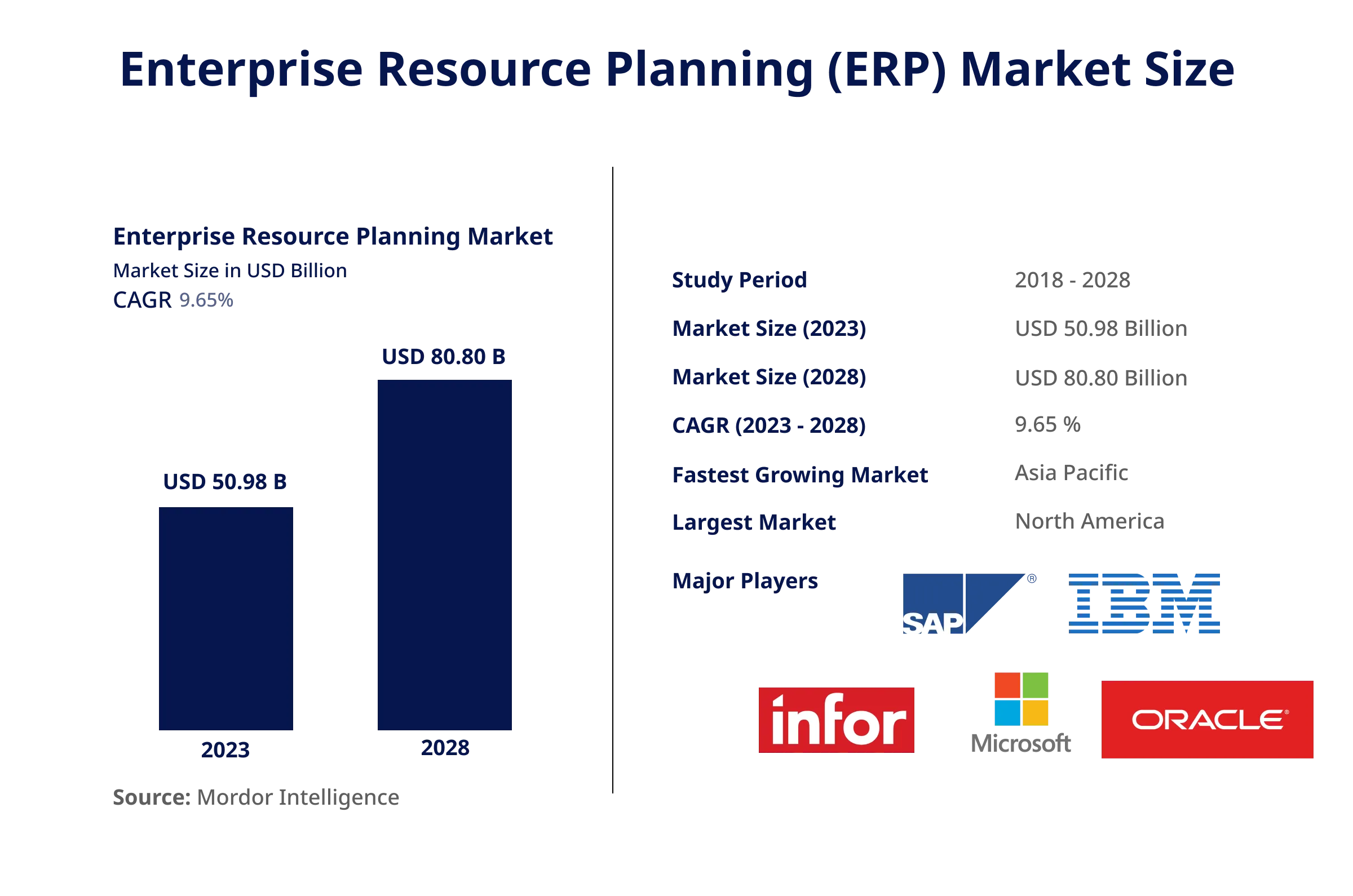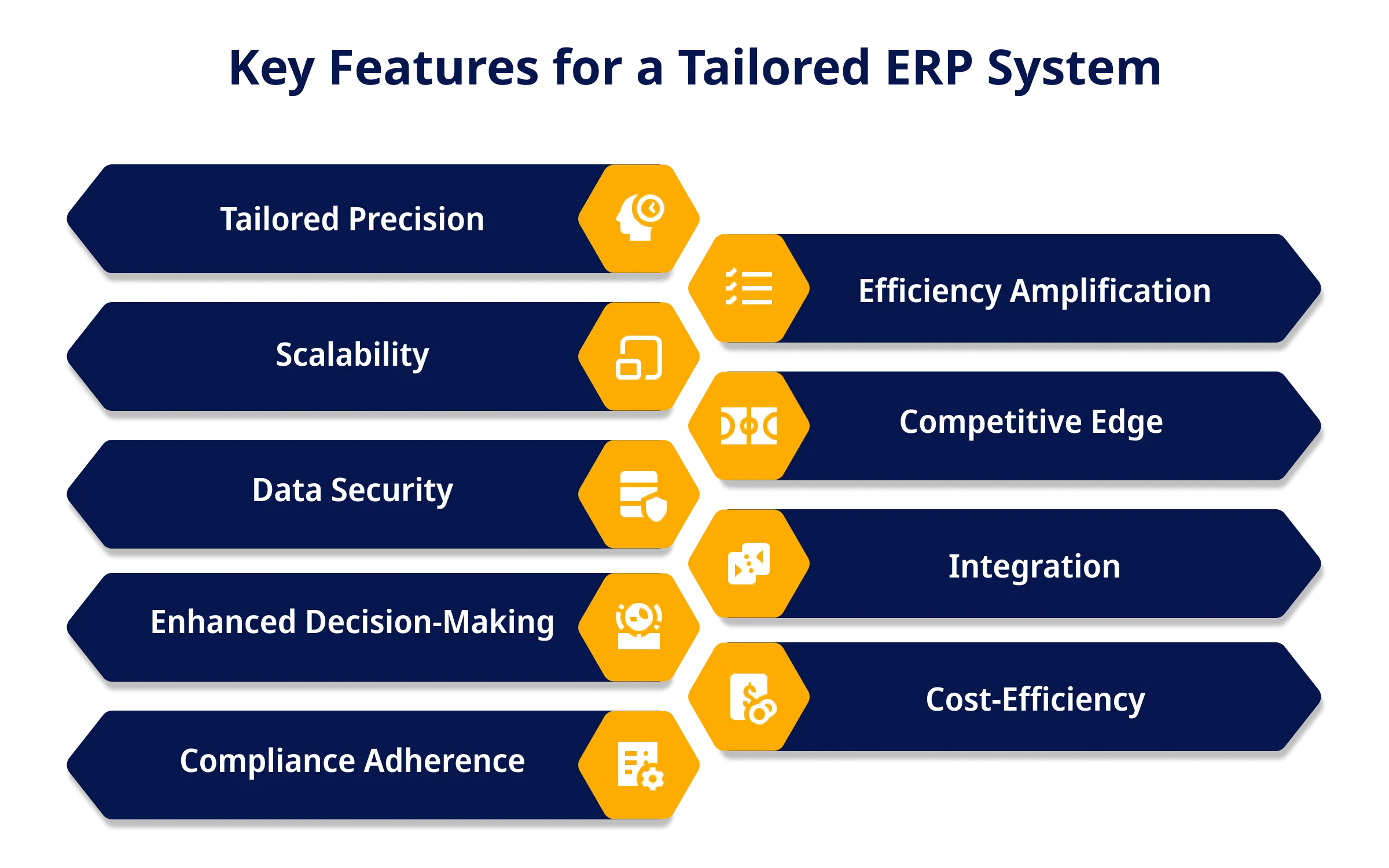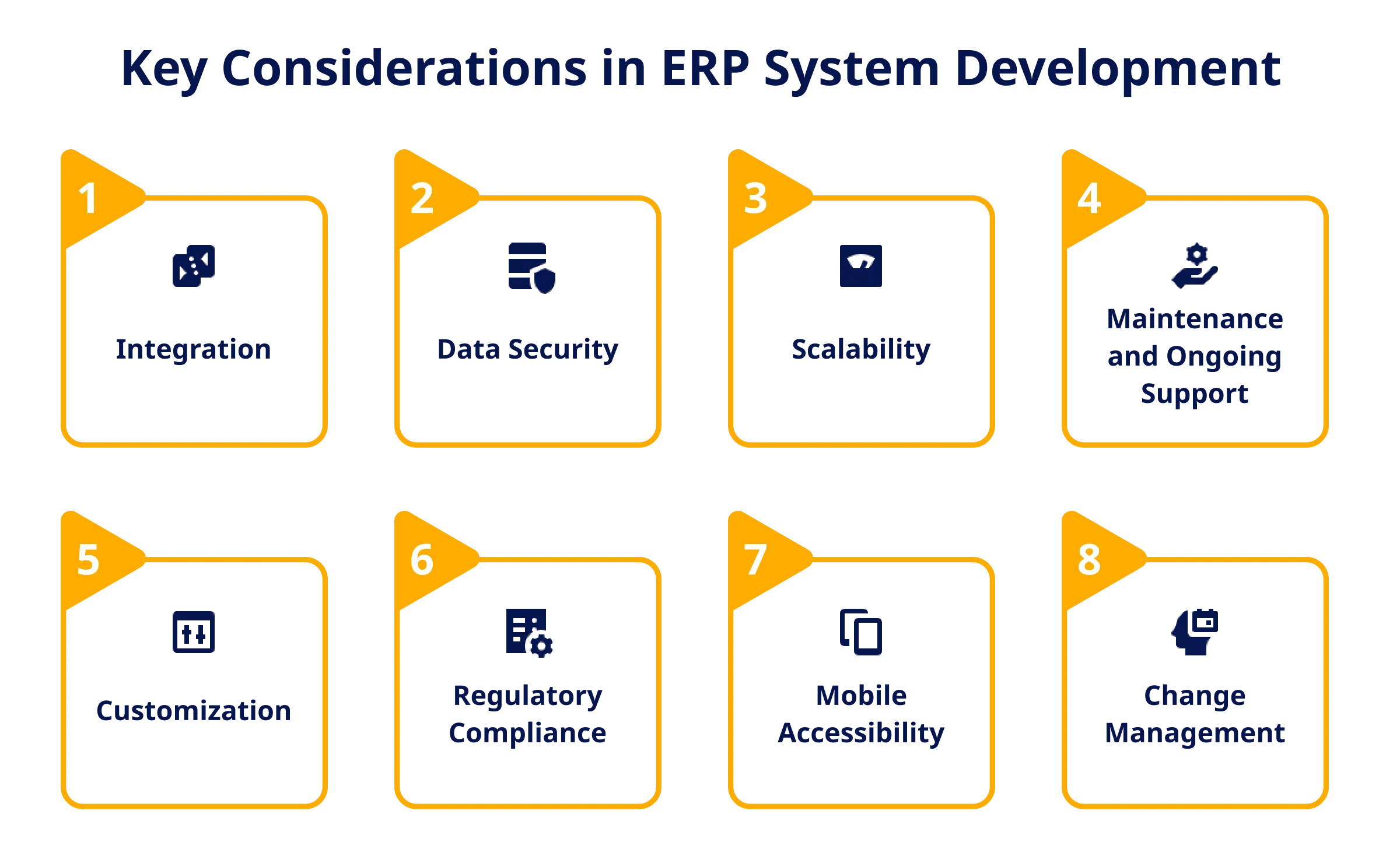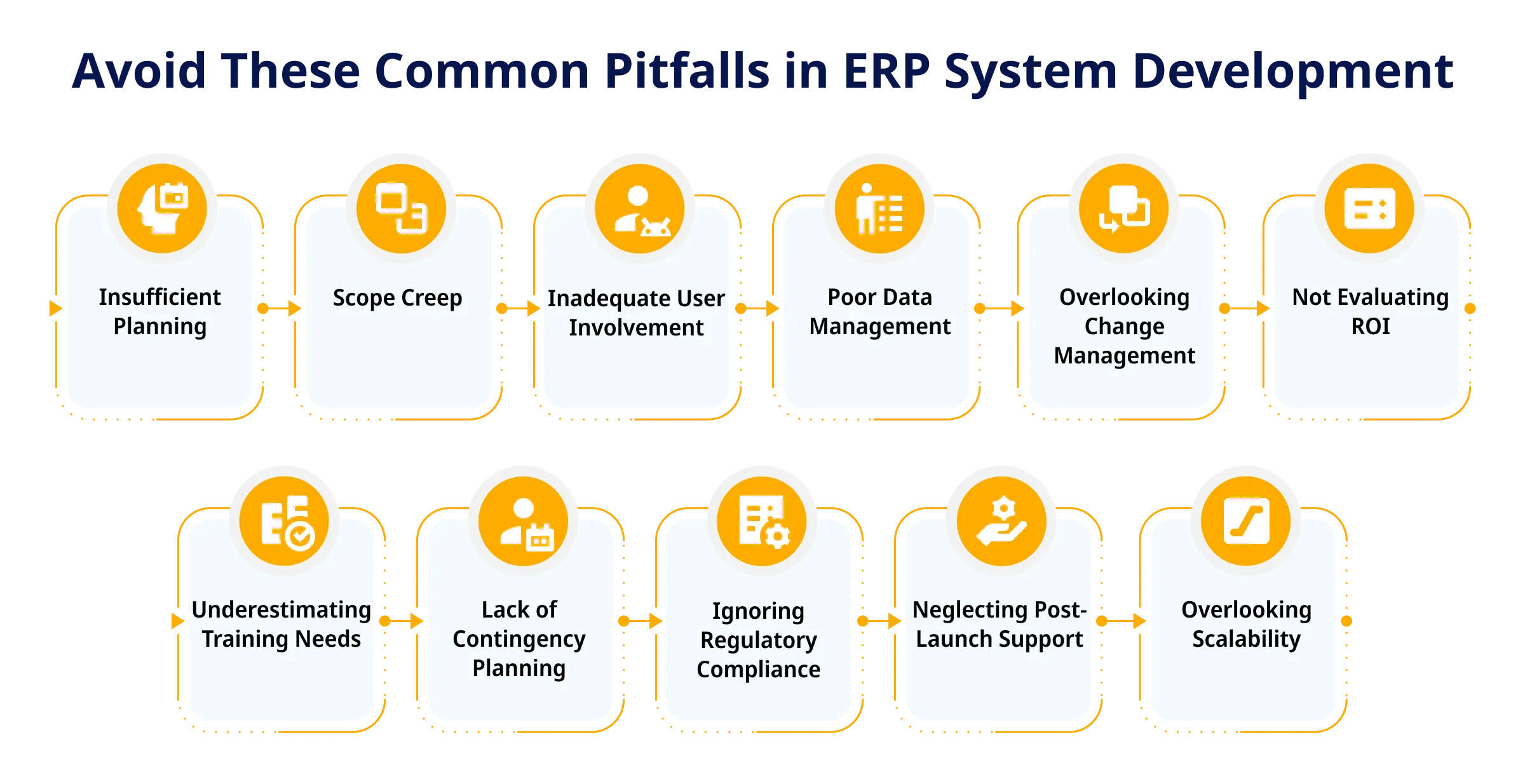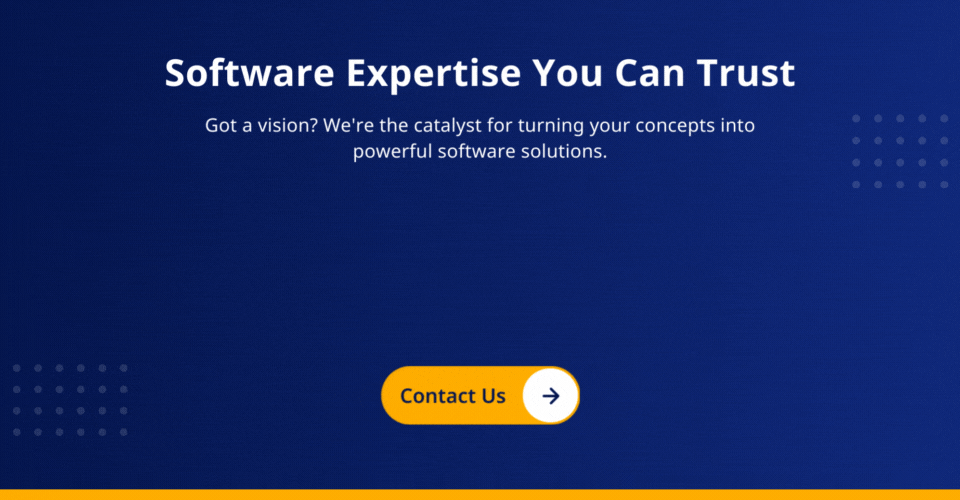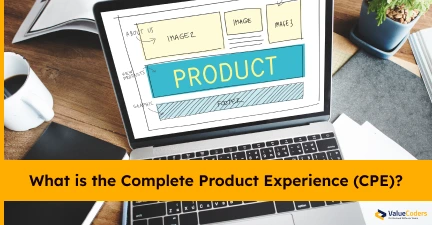Implementing a new ERP system can be a daunting and expensive endeavor, with failed projects costing companies over $7 million.
However, for many organizations, an off-the-shelf solution won’t provide the exact combination of features and capabilities they require.
As a result, companies are turning to tailored, customizable ERP platforms built specifically for their needs. This blog will explore core considerations for enterprise leaders and IT teams, beginning with custom ERP initiatives. You’ll discover:
- The must-have features to drive value
- Technical architecture and stack decisions
- Steps for streamlined development
- Budgeting realistically for an ERP platform
By understanding the key technical elements, implementation steps, and real-world costs, you’ll be equipped to create a streamlined ERP that enhances operations, provides actionable insights, and delivers maximum value for your investment.
Whether you’re an executive or IT leader exploring ERP options, this guide provides invaluable information to make your tailored ERP project successful.
Enterprise Resource Management Overview
ERP (Enterprise Resource Planning) system is an integrated suite of applications that empowers organizations to manage and automate their core business processes.
It’s the orchestrator of everything from finance and HR to supply chain and customer relations.
Almost 53% of organizations have witnessed positive ROI from ERP implementation in their business.
This states ERP system integration can boost your business and help you achieve desired results.
According to the report, The Enterprise Resource Planning (ERP) market size is predicted to grow from USD 50.98 billion in 2023 to USD 80.80 billion by 2028 at a CAGR of 9.65% during the forecast period (2023-2028).
Source: Mordor Intelligence
As technology becomes more and more personalized, custom ERP development emerges as the beacon of tailored efficiency.
Unlike off-the-shelf solutions, custom ERP services allow businesses to mold the system precisely to their unique needs.
Why Consider Custom ERP Development For Business?
Custom ERP development offers a tailored solution that aligns seamlessly with your unique operational needs, serving as a powerful catalyst for growth and efficiency.
Here are compelling reasons why businesses should consider embracing custom ERP solutions:
- Tailored Precision: Custom ERP development ensures that every feature and function is designed specifically for your business. No wasted resources on unnecessary functionalities.
- Efficiency Amplification: Your business processes become streamlined, reducing manual work, minimizing errors, and accelerating productivity.
- Scalability: As your business evolves, so should your ERP system. Custom solutions are scalable, accommodating growth without disruptions.
- Data Security: Custom ERP solutions can be fortified with robust security measures, safeguarding sensitive business data.
- Integration Flexibility: Seamless integration with other enterprise software applications becomes effortless, fostering cohesion in your tech ecosystem.
- Cost-Efficiency: In the long run, custom ERP development can be cost-effective, as you only pay for the features you need.
- Compliance Adherence: Tailored ERP systems can be designed to meet industry-specific regulatory requirements.
Upgrade to an ERP built for your needs.
Essential Features of a Tailored ERP System
A tailored ERP system emerges as the compass guiding organizations toward streamlined efficiency and enhanced productivity in the intricate business operations landscape.
To appreciate its significance fully, it’s essential to delve into the core features that make custom ERP development a strategic imperative.
- Streamlined Integration: Custom ERP development excels in harmonizing diverse business functions. It seamlessly integrates finance, human resources, supply chain, and more into a unified ecosystem, ensuring fluid data flow.
- Scalability: Custom ERP systems scale gracefully with your business. They evolve in tandem with your growth, sparing you from costly overhauls.
- User-Friendly Interface: Navigating a custom ERP system is intuitive. Tailored interfaces cater to your team’s specific needs, reducing training time and fostering user adoption.
- Real-Time Data: In the age of instant decision-making, custom ERP services deliver. Real-time data access empowers swift responses to market shifts and evolving customer demands.
- Custom Reports and Dashboards: Tailored reporting and dashboard options present critical data in an easily digestible format, empowering informed decision-making at all levels of your organization.
- Enhanced Security: Data security is paramount. Custom ERP systems can be fortified with robust security features, safeguarding your sensitive business information.
- Cost-Efficiency: Custom ERP development can be cost-effective, contrary to common belief. You invest only in the features you need, eliminating excess expenses.
- Industry Compliance: Tailored ERP systems can be molded to meet industry-specific regulations and compliance standards, ensuring your business operates within legal boundaries.
Custom ERP development, the cornerstone of custom ERP services, isn’t a luxury—it’s a strategic necessity.
The conductor orchestrates efficiency, innovation, and adaptability in your business, propelling you ahead in a dynamic business landscape.
Related Post: Choose The Best For Your Next Project
Development Guide: Steps to Building Your Tailored ERP System
If you are planning custom ERP development for your business, remember it is an intricate task that requires attention to detail and flawless work.
To navigate this complex but rewarding path successfully, we have listed some key steps that might help you do that efficiently.
These steps will help you with not just the development but also with ERP system architecture or integration. So, let’s find out:
1. Initial Planning: First, you must begin with a comprehensive assessment of your organization’s needs and objectives. Identify pain points, inefficiencies, and opportunities that the custom ERP system will address.
2. Development Approach: You must decide whether in-house development or software outsourcing services align best with your resources and expertise. Each has its merits and considerations.
3. Design and Development: A balance of design and development is crucial for successful ERP software development. Collaborate closely with skilled developers and designers to create a blueprint encapsulating your vision. Focus on user interface design, functionality, and scalability.
4. Testing and Quality Assurance: Rigorous testing ensures your custom ERP system operates flawlessly. From functionality checks to security audits, this phase is paramount.
5. Deployment and User Training: Roll out your custom ERP system gradually to minimize disruptions. Provide comprehensive training to users to maximize adoption and ROI.
6. Feedback Loop: Establish an ongoing feedback mechanism for users to report issues and suggest improvements. Observe and monitor to know if ERP software customization is required. Custom ERP development is a continuous journey of refinement.
7. Integration Strategy: Ensure seamless ERP system integration with existing software and data sources. Data consistency and accuracy are non-negotiable.
8. Data Migration: Migrate data from legacy systems to the new ERP smoothly. Data integrity is pivotal for informed decision-making.
9. Maintenance and Support: Enlist a dedicated team for ongoing ERP system maintenance, updates, and user support to keep your system operating at its peak.
10. Cost Considerations: Track and manage custom ERP costs throughout development, including initial investments and long-term operational expenses.
ERP system development process is a fusion of technology and strategy. The abovementioned process is not a one-size-fits-all approach because diverse businesses have unique needs. Hence, each step must align with the organization’s goals.
By following this development guide, you’ll be poised for success in harnessing the full potential of your tailored ERP system.
Automate key activities with a modern ERP solution.
Key Considerations in ERP System Development
To ensure a successful project, you can contact the best custom software development companies.
Their quality services will take care of your company’s ERP system development process.
Those having in-house teams should ensure their ERP system project management team follows the following points:
- Integration with Existing Systems: Seamlessly integrating your new ERP system with your existing software and data sources is crucial. Data consistency and accurate cross-system communication are non-negotiable.
- Data Security and Privacy: Data breaches can be catastrophic. Implement robust security measures to safeguard sensitive information and ensure compliance with data privacy regulations.
- Mobile Accessibility: In an increasingly mobile-centric world, ensuring your ERP system is accessible and functional on mobile devices is essential for flexibility and remote operations.
- Scalability: Your business will evolve, and for that, you must ensure the ERP system scalability, which can scale along with your business. This will help accommodate growth without significant disruptions or costly reconfigurations.
- Maintenance and Ongoing Support: Post-launch, continuous maintenance, updates, and user support are critical. A dedicated Enterprise software development team for these needs is a wise investment.
- User Training: User adoption is key to realizing the full benefits of your ERP system. Comprehensive training programs ensure that your team can effectively utilize the system.
- Customization: Tailor your ERP system to your specific industry and organizational needs. Avoid a one-size-fits-all approach to maximize efficiency.
- Business Continuity Planning: Develop contingency plans to mitigate the impact of system outages or failures. Ensuring business continuity is vital.
- Budgetary Constraints: Track and manage costs throughout development, accounting for initial investments and long-term operational expenses.
- Regulatory Compliance: Depending on your industry, your ERP system may need to adhere to specific regulations. Ensure that your system meets all compliance requirements.
- Change Management: Acknowledge that implementing a new ERP system may entail changes in workflows and processes. Effective change management strategies are essential for a smooth transition.
To explore ERP software development trends, read our latest blog post on “Staying Ahead In Enterprise Software: Latest Trends And Technologies.” It will give you in-depth information on the latest technologies for enterprise software.
Our experienced team navigates the complexities.
Cost Analysis: Budgeting for Your Tailored ERP System
Now, let’s look at the critical aspects you should consider when evaluating the costs of your tailored ERP development:
#1. Initial Development Costs: Start by estimating the upfront costs, which include software development, customization, hardware procurement, and consulting fees. Ensure you have a detailed breakdown of these expenses.
#2. License and Subscription Fees: Factor in ERP software licensing fees and ongoing subscription costs. Some ERP solutions charge on a per-user common challenges.
#3. Implementation Costs: Beyond software costs, you should also consider expenses related to the implementation process, such as data migration, integration with existing systems, and employee training.
#4. Maintenance and Support: Budget for ongoing maintenance and support, which may include software updates, troubleshooting, and helpdesk services. These are essential for system longevity.
#5. Infrastructure and Hardware: Assess your hardware requirements, including servers, networking equipment, and storage devices. Ensure your infrastructure can support the ERP system effectively.
#6. Customization Expenses: Tailoring your ERP system to your needs may incur additional development costs. Account for these customization expenses.
#7. User Licenses: Determine the number of user licenses needed and calculate the associated costs. Some ERP solutions charge based on concurrent users or named users.
#8. Consulting and Professional Services: If you enlist external consultants or experts, allocate a budget for their services, which can be invaluable for project guidance and risk mitigation.
#9. Training Costs: Training employees to use the new ERP system is crucial. Consider expenses related to training materials, trainers, and the time employees spend away from their regular tasks. To avoid this cost, you can hire the top 1% of software developers across the globe who have expertise in ERP software customization.
#10. Contingency Budget: It’s wise to have a contingency fund to address unexpected costs that may arise during the ERP implementation.
#11. Total Cost of Ownership (TCO): Calculate the TCO over the expected lifespan of your ERP system, factoring in all ongoing expenses, to understand the true cost over time.
The cost of the ERP system development process may vary from business to business however, these key points will lead you in the right direction.
Common Pitfalls to Avoid
Here are some common challenges you might encounter during the ERP system development process. Some include:
- Insufficient Planning: Rushing into ERP development without a well-defined plan can misalign your business needs.
- Scope Creep: Beware of scope creep, where the project gradually expands beyond the initial scope.
- Inadequate User Involvement: User input is invaluable. Failing to involve end-users in the design and testing phases can result in an ERP system that doesn’t meet their needs.
- Poor Data Management: Neglecting data migration and quality can disrupt operations. Ensure meticulous data cleansing and migration strategies are in place.
- Overlooking Change Management: Employees need support adapting to the new system. Neglecting change management can lead to resistance and reduced adoption rates.
- Not Evaluating ROI: Regularly measure the return on investment (ROI) to ensure the ERP system delivers the expected benefits and justifies the investment.
- Underestimating Training Needs: Adequate user training is essential for system adoption. Allocate sufficient time and resources for comprehensive training programs.
- Lack of Contingency Planning: Not preparing for contingencies can leave you vulnerable to unexpected issues. Build a contingency plan to address potential roadblocks.
- Ignoring Regulatory Compliance: Industries like healthcare and finance have specific regulations. Neglecting compliance can result in legal consequences and operational disruptions.
- Neglecting Post-Launch Support: The project isn’t over at launch. Plan ongoing support and maintenance to address issues and optimize the system.
- Overlooking Scalability: Ensure your ERP system can scale with your business. Failing to consider scalability can lead to costly system replacements down the line.
Future Trends in ERP Systems
To stay ahead, here are some key future trends to watch:
- Cloud Migration: According to MarketSpalsh post, cloud-based ERP solutions will make up 45% of all ERP software implementations in 2023. ERP systems are increasingly moving to the cloud, offering enhanced accessibility, scalability, and cost-effectiveness.
- AI and Machine Learning: Integrating AI and machine learning will enable predictive analytics, automation, and smarter decision-making within ERP systems. IDC stated AI software market for ERP is estimated to reach $4.5 billion by 2024.
- IoT Integration: IoT (Internet of Things) connectivity will provide real-time data from connected devices, enhancing inventory management and supply chain efficiency.
- Blockchain for Transparency: Blockchain technology will be used for secure and transparent transactions, especially in industries like finance and healthcare.
- Mobile Accessibility: Mobile ERP solutions will become more prevalent, allowing users to access critical data and perform tasks on the go.
- Integration with Business Intelligence: Tighter integration with BI tools will enable data-driven insights and reporting within ERP systems.
- Cybersecurity Measures: ERP systems will prioritize robust security features to protect sensitive business data as cyber threats evolve.
Our consultants can optimize the platform for peak performance
Final Thoughts
Organizations can fit their systems with their particular demands with custom ERP systems, encouraging productivity, scalability, and adaptability.
Planning carefully is necessary to create a bespoke ERP system budget considering early costs and long-term viability. At ValueCoders, our team of seasoned experts is here to ensure your ERP system is not only a success but also a wise investment for the future.
Poor planning, scope creep, and ignoring user involvement are common issues. Businesses can stay competitive by adapting to trends like cloud migration, AI integration, and mobile accessibility.
With cloud migration, AI integration, mobile accessibility, and custom API development reshaping the environment, the future of ERP systems is promising.
Businesses should consider these aspects as a strategic investment to realize the full potential of their tailored ERP system and enjoy long-term success.


